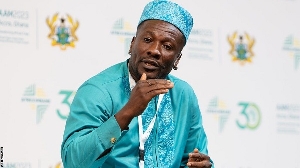Ghana, Senegal & Uganda met virtually with international financial partners and risk analysts to discuss the most urgent risks and mitigation solutions at ATI’s (www.ATI-ACA.org) annual Roundtable; Analysts noted that Africa is expected to see a subdued economic recovery in 2021 and not likely to reach 2019 growth levels till 2022; Debt defaults are likely to be contained to a small subset of countries with little chance of contagion spreading to other countries in the region.
At the African Trade Insurance Agency’s (ATI) Annual Investor Roundtable, investors, risk analysts and African governments weighed in on the prospects for the region to recover from the impacts of COVID-19. Analysts predicted a subdued recovery in 2021 with the possibility of countries not returning to 2019 growth levels till 2022.
Manuel Moses, ATI’s newly appointed Chief Executive Officer opened the session by emphasizing the importance of partnerships to help African economies recover from this unprecedented pandemic. He also noted ATI’s focus on lending more support to the most vulnerable economies, which the company plans to do through rapid membership expansion in the coming months with the support of partners like the European Investment Bank and the African Development Bank.
The session revealed several key factors that should guide the continent’s recovery. Notably, one of the striking features of the pandemic’s impact is that, unlike previous economic shocks that left their mark largely on commodity-dependent countries, for example, this pandemic is affecting a broader swathe of countries including more diversified economies and those reliant on tourism and the aviation sectors.
The IMF estimates that US$345 billion will be required in the next three years to help countries fully recover from the economic impacts of COVID-19, while the most comprehensive debt support initiative – the G20’s debt service suspension initiative (DSSI) will only provide US$6.5 billion to eligible countries through to June 2021. And the tangle of non-traditional financing sources, from the Middle East and Asia, for example, is adding even greater complexity to the debt issue.
Analysts also noted that there aren’t really any surprises given that countries likely to be the most resilient are those, such as Senegal and Uganda, which had sound fiscal and monetary policies in place before the pandemic while countries that were already vulnerable before the pandemic are predicted to fair worse with average debt burdens rising to 60% of GDP in 2020 compared to 40% in 2015.
Here are some additional highlights from the session.
Africa was spared significant health impacts but vigilance is still needed Dr Robert Besseling, Founder and CEO of Pangea-Risk noted that so far, the pandemic seems to have impacted mostly North and Southern Africa. Each region accounts for 1/3 of the cumulative infections with Egypt and Morocco bearing the brunt of most of the infections in the North while South Africa alone accounts for 1/3 in the Southern region. However daily rates show that Africa on a whole, including countries in the East and West, are well on their way to experiencing a second wave. Currently there are 2.2 million cumulative infections with 300,000 active.
Debt default contagion limited to a few countries and has not spread Speakers noted that rating actions have been measured and focused on where risks are highest and most pressing, which tend to be the less dynamic performers in the Single B category. In 2020, Moody’s took the most ratings actions, 20 in total, since 2016 and were focused on a small subset of countries, where the COVID shock exacerbated pre-existing credit weakness prior to the pandemic leaving these countries more susceptible to shocks and possible negative ratings.
By 2021, six African countries are expected to record government gross debt over 100% of GDP while debt burdens overall were expected to rise then stabilize by 2021/2022 above 60% of GDP. The most vulnerable countries are well known to the markets and have had pre-existing challenges. Given the isolated nature of current defaults, the general trend does not show any threat of regional spread or contagion.
The challenge going forward, is that these countries don’t have a historic track record of stabilizing such a rise in debt levels. Fiscal consolidation and revenue generation will be some of the factors needed to improve their credit quality over time.
African governments stress the need to treat countries individually In laying out their strategies, the participating government representatives from Ghana, Senegal and Uganda all highlighted their uniqueness, which they felt should be a key factor in any discussion with partners interested in supporting pandemic recovery efforts on the continent.
The other key issue to emerge is that these countries are proactively putting in place strategic recovery plans that are both a continuation of their efforts to build sustainably while also laying the groundwork to cushion their economies against future shocks.
Senegal, for instance, as mentioned by Khalifa Sarr, an Advisor to the Minister of Economy, Planning and International Partnerships, is ranked as second out of 36 countries globally for their COVID response. This could not have been achieved, noted Mr Sarr, if the government hadn’t implemented a US$1.7 billion economic & social resiliency program in early April this year, representing 7% of their GDP. Sarr also commented that the international community should recognise that not all debt is equal.
This socio-economic program, he added, is credited for saving thousands of lives and strengthening social infrastructure that will protect against future pandemics while adding to the next phase of their recovery program aimed at attracting the private sector through a new PPP framework and policies that will ease bureaucracy for investors.
Uganda has also taken a proactive stance. Despite being in the midst of a presidential election, Moses Kaggwa, the Director of Economic Affairs in the Ministry of Finance remarked that the country is expected to grow by 2.9% this year and 3.5-4% in 2021 – one of Africa’s top performers. And with a focus on generating jobs within the agriculture sector, which accounts for the employment of 70% of the population, they are ramping up value addition of some of these exports in addition to domestic tourism while the Uganda Development Bank is bridging the current financing gap to manufacturing and agribusiness.
Combined, these measures are expected to aid in the country’s post-pandemic recovery in a way that impacts a majority of the population.
Likewise, Ghana, with a well-diversified economy, was helped by stable cocoa prices and a resurgent interest by investors in gold, which countered the effects of the downturn in oil prices according to Samuel Arkhurst, the Chief Economics Officer and Director of Treasury and the Debt Management Division. In addition, Ghana implemented a cash program that will stabilise the economy in the short-term and revitalize all sectors as the country emerges from the pandemic. Mr Arkhurst added that Ghana is fully committed to its medium-term debt strategy and expects to return to the Eurobond market in 2021.
Multilaterals urged to rethink their approach to supporting sovereigns Investors, represented by Dr Christopher Marks, a Managing Director at MUFG, appealed to multilaterals to rethink their approach to supporting sovereigns by focusing on financing social as well as more traditional infrastructure development projects that will not include sovereign guarantees. This, noted Dr Marks, will provide more space on the balance sheets of commercial banks, like MUFG, to be able to provide more support as governments begin the process of strengthening their economies.
The annual Roundtable provides a platform for international investors, financiers and other stakeholders from the private sector to have open and honest exchanges with African governments about current investment and trade risks and potential solutions. The speakers at this year’s event included:
David Rogovic, Vice President & Senior Analyst, Sovereign Risk Group at Moody’s Investors Service; Samuel Arkhurst, Chief Economics Officer and Director of Treasury and the Debt Management Division, Ghana; Khalifa Sarr, Advisor in the Ministry of Economy, Planning & International Partnerships, Senegal; Mr. Moses Kaggwa, Director of Economic Affairs, Ministry of Finance, Planning and Economic Development, Uganda; Dr Christopher Marks, Managing Director, Head of Emerging Markets, Corporate Banking EMEA at MUFG; and Moderation provided by Dr Robert Besseling, Founder and CEO of Pangea-Risk Distributed by APO Group on behalf of African Trade Insurance Agency (ATI).
Media Contact: Sheila Ongas Communications Officer Sheila.Ongas@ati-aca.org Mobile +254 728 600 180
About the African Trade Insurance Agency: ATI (www.ATI-ACA.org) was founded in 2001 by African States to cover the trade and investment risks of companies doing business in Africa. ATI predominantly provides Political Risk, Credit Insurance and, Surety Insurance. In 2019, ATI closed the year with exposures of US$6.4 billion and continued to post record results for the eighth consecutive year with 132% growth on the net profit over 2018 owing to strong demand for ATI’s insurance solutions from the international financial sector and from African governments. Since inception, ATI has supported US$62 billion worth of investments and trade into Africa. And for over a decade, ATI has maintained an ‘A/Stable’ rating for Financial Strength and Counterparty Credit by Standard & Poor’s, and in 2019, ATI obtained an A3/Stable rating from Moody’s.
Click to view details



Business News of Monday, 14 December 2020
Source: goldstreetbusiness.com

















